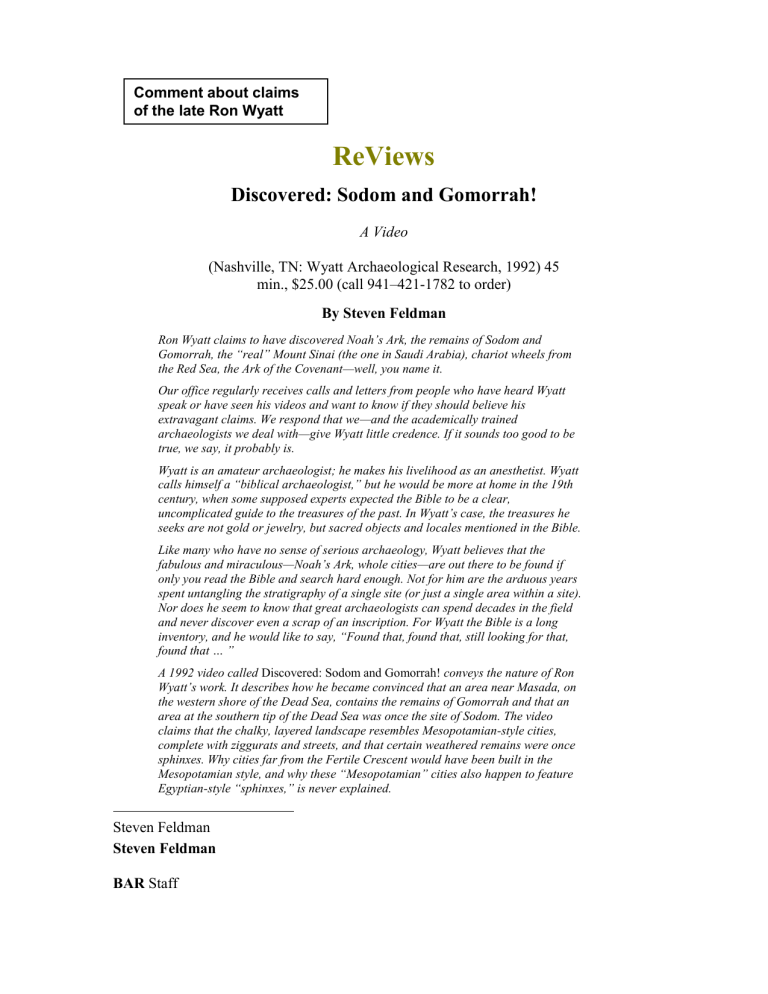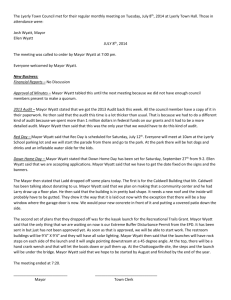BAR Comment about Ron Wyatt

Comment about claims of the late Ron Wyatt
ReViews
Discovered: Sodom and Gomorrah!
A Video
(Nashville, TN: Wyatt Archaeological Research, 1992) 45 min., $25.00 (call 941–421-1782 to order)
By Steven Feldman
Ron Wyatt claims to have discovered Noah’s Ark, the remains of Sodom and
Gomorrah, the “real” Mount Sinai (the one in Saudi Arabia), chariot wheels from the Red Sea, the Ark of the Covenant—well, you name it.
Our office regularly receives calls and letters from people who have heard Wyatt speak or have seen his videos and want to know if they should believe his extravagant claims. We respond that we—and the academically trained archaeologists we deal with—give Wyatt little credence. If it sounds too good to be true, we say, it probably is.
Wyatt is an amateur archaeologist; he makes his livelihood as an anesthetist. Wyatt calls himself a “biblical archaeologist,” but he would be more at home in the 19th century, when some supposed experts expected the Bible to be a clear, uncomplicated guide to the treasures of the past. In Wyatt’s case, the treasures he seeks are not gold or jewelry, but sacred objects and locales mentioned in the Bible.
Like many who have no sense of serious archaeology, Wyatt believes that the fabulous and miraculous—Noah’s Ark, whole cities—are out there to be found if only you read the Bible and search hard enough. Not for him are the arduous years spent untangling the stratigraphy of a single site (or just a single area within a site).
Nor does he seem to know that great archaeologists can spend decades in the field and never discover even a scrap of an inscription. For Wyatt the Bible is a long inventory, and he would like to say, “Found that, found that, still looking for that, found that … ”
A 1992 video called Discovered: Sodom and Gomorrah!
conveys the nature of Ron
Wyatt’s work. It describes how he became convinced that an area near Masada, on the western shore of the Dead Sea, contains the remains of Gomorrah and that an area at the southern tip of the Dead Sea was once the site of Sodom. The video claims that the chalky, layered landscape resembles Mesopotamian-style cities, complete with ziggurats and streets, and that certain weathered remains were once sphinxes. Why cities far from the Fertile Crescent would have been built in the
Mesopotamian style, and why these “Mesopotamian” cities also happen to feature
Egyptian-style “sphinxes,” is never explained.
Steven Feldman
Steven Feldman
BAR Staff
But the video rests its claims on geological arguments: The sites are not natural formations, and they are filled with sulfur balls—the brimstone the Bible says God rained on the sinful cities. Wyatt was especially impressed by the fact that he could crumble the remains like ash—that they were not rocks, but burnt remains (in his analysis). To evaluate Wyatt’s claims, we asked a geologist to view the video.
Reviewed by Elizabeth H. Gierlowski-Kordesch
Junk science has several warning signs: It advocates a cause, pays little attention to the investigative process, ignores contrary evidence and advertises a high moral purpose.
†
All these signals are present in the claims of Ron Wyatt, of the Wyatt Archaeological
Museum in Cornersville, Tennessee, and in his “discovery” of the ashen remains of
Sodom and Gomorrah along the Dead Sea.
Wyatt, with no academic background in archaeology or geology, claims that the whitish, layered geological formations along the western coastline of the saline lake are the remains of these Biblical cities and that they are composed of ash, though no chemical composition is ever given. He even goes on to claim that the layering is caused by some bizarre process of “thermal ionization” (whatever that is) during burning at 4000–6000°
Fahrenheit. Rhylolites (a type of granite) and basalts, the rocks of volcanoes, start to melt at 1500–1700° F. Wyatt’s scenario is not possible on the surface of the earth. You would have to approach the center of the planet to reach 4000° F.
The geological formations that Wyatt mistakes for ancient cities are simply lake sediments that accumulated when the Dead Sea was larger and deeper, back in the Late
Pleistocene period (an epoch ranging from 700,000 to 10,000 years before the present).
†
(Geologists call that older body of water Lake Lisan.) The layering visible today is similar to those of sediments and sedimentary rocks found everywhere—no surprise there. Some beautifully contorted layers within these ancient lake sediments are signs of earthquake activity in the region;
*
these are called “seismites,” sub-lacustrine sediments disturbed by earthquake (seismic) activity. The lake sediments are not lithified (cemented into rocks) because of their relatively young age (40,000 to 60,000 years old), so they
Elizabeth H. Gierlowski-Kordesch
Elizabeth H. Gierlowski-Kordesch
Elizabeth H. Gierlowski-Kordesch, Ph.D., a limnogeologist, is co-editor of Global
Geological Record of Lake Basins (Cambridge, UK: Cambridge Univ. Press, 1994) and the author of many articles on ancient lake deposits.
† Ron W. Pritchett, “Recognizing Junk Science,” The Professional Geologist (December
1997), pp. 5–7.
† David Neev and Kenneth O. Emery, “The Dead Sea: Depositional Processes and
Environments of Evaporites,”
State of Israel, Ministry of Development, Geological
Survey , Bulletin 41 (Jerusalem, 1967); Amihai Sneh, “Late Pleistocene Fan-Deltas Along the Dead Sea Rift,”
Journal of Sedimentary Petrology 49:2 (1979), pp. 541–552.
* See Amos Nur and Hagai Ron, “Earthquake! Inspiration for Armageddon,”
BAR
23:04.
would crumble easily in someone’s hand—which explains why Wyatt confuses them with ash.
The minerals that make up these Pleistocene period whitish sediments (called the Lisan
Formation or detrital laminated chalk facies) are calcite (lime) and gypsum (plaster of paris); these minerals are whitish and very soft. Clays are a minor component of the sediments. The composition of these Lake Lisan sediments is not unusual, since the drainage area contains these constituents in abundance (remember that the exposed areas near today’s shoreline were once part of the lakebed). The formations result from the normal processes of weathering and erosion over thousands of years.
Because the Dead Sea is a lake within an active rift zone,
†
lake-level changes and the resulting sediments reflect the active tectonic setting and climatic changes through time.
The sediments of the Lisan Formation obviously do not cover the entire bottom of the valley containing the Dead Sea because erosion destroyed many of the soft sediments after the level of Lake Lisan went down. The extent of the present-day Lisan Formation and its strangely shaped geological features are the result of the changing climate of the
Dead Sea region during the time of exposure. The normal erosional pattern of the drainage areas dissecting the whitish chalk formation could even resemble streets to someone with a wild imagination! People have always detected shapes in the eroded columns of sedimentary rocks. At Arches and Canyonlands National Parks in Utah, for example, the sandstone shapes are given picturesque names such as Sheep Rock, Three
Gossips and the Needles.
Wyatt’s main “proof” that these geological formations are the remains of Sodom and
Gomorrah is the presence of round sulfur balls in the chalk facies of the Lisan Formation.
Chemical analysis of these balls indicates a 95.72 percent sulfur composition. It is not clear whether this is by weight or volume, but the result is not surprising, since these sulfur nodules contain portions of the surrounding sediment (gypsum is hydrated calcium sulfate) and the degraded organic remains of animals buried in the sediments (sulfur is an important component of living tissue). This type of post-depositional chemical feature within lake sediments is a common phenomenon in ancient lakes around the world.
The verdict on this video? Beware of junk
1
† Tina Niemi, Zvi Ben-Avraham and Joel R. Gat, eds.,
The Dead Sea: The Lake and Its
Setting (New York: Oxford Univ. Press, 1997).
1 Editor, H. S. BAR 24:05 (Sep/Oct 1998) . Biblical Archaeology Society, 2004; 2004.








